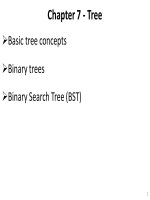Lecture Data communications and networks: Chapter 17 - Forouzan
Bạn đang xem bản rút gọn của tài liệu. Xem và tải ngay bản đầy đủ của tài liệu tại đây (1.05 MB, 50 trang )
Chapter 17
SONET/SDH
17.1
Copyright © The McGrawHill Companies, Inc. Permission required for reproduction or display.
Note
SONET was developed by ANSI;
SDH was developed by ITU-T.
17.2
17-1 ARCHITECTURE
Let us first introduce the architecture of a SONET
system: signals, devices, and connections.
Topics discussed in this section:
Signals
SONET Devices
Connections
17.3
Table 17.1 SONET/SDH rates
17.4
Figure 17.1 A simple network using SONET equipment
17.5
17-2 SONET LAYERS
The SONET standard includes four functional layers:
the photonic, the section, the line, and the path layer.
They correspond to both the physical and the data link
layers.
Topics discussed in this section:
Path Layer
Line Layer
Section Layer
Photonic Layer
Device–Layer Relationships
17.6
Note
SONET defines four layers:
path, line, section, and photonic.
17.7
Figure 17.2 SONET layers compared with OSI or the Internet layers
17.8
Figure 17.3 Device–layer relationship in SONET
17.9
17-3 SONET FRAMES
Each synchronous transfer signal STSn is composed
of 8000 frames. Each frame is a twodimensional
matrix of bytes with 9 rows by 90 × n columns.
Topics discussed in this section:
Frame, Byte, and Bit Transmission
STS1 Frame Format
Encapsulation
17.10
Figure 17.4 An STS1 and an STSn frame
17.11
Figure 17.5 STS1 frames in transmission
17.12
Note
A SONET STS-n
signal is transmitted at
8000 frames per second.
17.13
Note
Each byte in a SONET frame can carry a
digitized voice channel.
17.14
Example 17.1
Find the data rate of an STS1 signal.
Solution
STS-1, like other STS signals, sends 8000 frames per
second. Each STS-1 frame is made of 9 by (1 × 90) bytes.
Each byte is made of 8 bits. The data rate is
17.15
Example 17.2
Find the data rate of an STS3 signal.
Solution
STS-3, like other STS signals, sends 8000 frames per
second. Each STS-3 frame is made of 9 by (3 × 90) bytes.
Each byte is made of 8 bits. The data rate is
17.16
Note
In SONET, the data rate of an STS-n
signal is n times the data rate
of an STS-1 signal.
17.17
Example 17.3
What is the duration of an STS1 frame? STS3 frame?
STSn frame?
Solution
In SONET, 8000 frames are sent per second. This means
that the duration of an STS-1, STS-3, or STS-n frame is
the same and equal to 1/8000 s, or 125 μs.
17.18
Note
In SONET,
the duration of any frame is 125 μs.
17.19
Figure 17.6 STS1 frame overheads
17.20
Figure 17.7 STS1 frame: section overhead
17.21
Note
Section overhead is recalculated for
each SONET device
(regenerators and multiplexers).
17.22
Figure 17.8 STS1 frame: line overhead
17.23
Figure 17.9 STS1 frame: path overhead
17.24
Note
Path overhead is only calculated for
end-to-end (at STS multiplexers).
17.25









